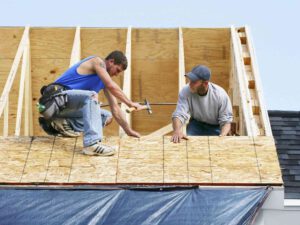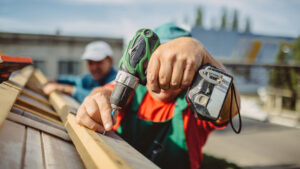The roof is one of the most important parts of a home. It protects the interior from sun, wind, rain, and snow. A damaged roof can cause leaks, rot, mildew, higher heating and cooling costs, and resale problems.
The first step is to find the source of the damage. This requires accessing the attic and looking for stains, holes, and leaking areas. For more information about roof repair visit Columbus Roof Repair.

Roof repair is a costly home improvement project. It’s a major endeavor that requires a significant amount of time and money to complete. That’s why it’s important to research before you call in a professional.
The roofing repair cost depends on several factors, including the type of damage and the structure of your roof. Minor repairs, such as a shingle replacement, will be less expensive than replacing an entire section of your roof. The type of material also plays a role in the overall cost, with some materials being more difficult to work with and, therefore, more expensive.
A roof inspection can help you determine the extent of any damage to your roof. You can perform a visual inspection or hire an expert to take high-resolution pictures of your roof. This way, you can spot any problems right away and make the necessary repairs.
It’s a good idea to inspect your roof at least once every two years. Some parts of your roof need more frequent attention than others. For example, if you have a skylight that leaks or the vents are cracked, it’s a good idea to get them repaired immediately. These issues can cause significant water damage inside your home and may even require replacing flooring, drywall, ceilings, and furniture.
Other common areas for roof repair include ridge caps, the triangular pieces that cap the peaks of roofs. These are prone to cracking and may need to be caulked or replaced entirely. Depending on the extent of the damage, this can cost $250-$750 on average.
You can also need to repair roof soffits and fascia, which are longboards that extend from the walls of a house to form the eaves. These are prone to damage from excessive moisture and insects. If they are damaged, it can lead to rot and mold. It typically costs $600-$6,000 to repair fascia and soffits.
You can save on the cost of a roof repair by performing it yourself or with a professional. However, you must remember that a DIY roof repair is only a temporary measure and will not last as long as a re-roofing.
There are a variety of materials that can be used for a roofing repair, depending on the type of roof. Composite shingles, for example, are popular because they are durable and affordable. However, they are also prone to cracking and brittleness. As such, it is important to ensure that the proper materials are used for a roofing repair to prevent water damage.
Other essential materials for a roof repair include a pry bar and shovel, which can be used to isolate the shingles or tiles that need replacing. This will allow the contractor to remove only the faulty ones and avoid damaging other roof parts. It is important to select a pry bar and shovel with non-slip handles for optimal safety when working on the roof.
A caulking gun and spreader are also essential for a roof repair. They can apply waterproof sealants around the vents, chimneys, and skylights. They are also useful for filling in any holes or cracks.
Roofing repair materials can be bought from various hardware stores and home improvement centers. However, it is advisable to work with a professional roofing contractor to ensure that the correct materials are used. They will also be able to advise on what materials are best suited for your home and the type of roof you have. This will ensure that your roof is protected from the elements and will last for years.
When installing roll roofing, you must have the right materials and tools. First, you’ll need to ensure that the roof’s surface is clean and free from debris. You should also remove any existing roofing materials or nails and replace them with new ones. It’s also a good idea to use an underlayment, either synthetic or felt, to protect the roof from moisture penetration. Next, you’ll need to apply the roofing cement with a trowel to the roof surface. Make sure to spread it evenly and cover the entire area.
After the cement has been applied, you can start laying the roll roofing. It’s recommended to lay the first strip horizontally and then overlap it with the adjacent strips. Once all the rolls are in place, you can nail them down with galvanized roofing nails about 6 to 10 inches apart. It’s also a good idea to add drip-edge metal flashing to prevent water from seeping under the roof.
It’s worth mentioning that rolled roofing has a short lifespan of about five to eight years, which makes it less durable than other types of roofing. It’s also one of the least attractive types of roofing and could be a better choice for outbuildings seen from the street. Some homeowner’s associations may also not allow it, especially if the structure is residential. A qualified roofing professional can help you choose the right roof for your property and ensure it complies with local regulations.
When performing a roofing repair, safety is of paramount importance. This is because working at heights poses several risks and may lead to injuries. Fortunately, by taking the proper precautions and following strict safety protocols, roofers can minimize these risks and keep their workers safe.
One of the most important measures that can be taken to ensure safety on the job site is the use of personal protective equipment (PPE). This includes hard hats, eye and face protection, and insulated gloves. PPE can help reduce the risk of falls, which can cause serious injury to the head or spinal cord. In addition, it can also help protect against other hazards, such as slipping on a nail or falling debris.
Another key measure is to designate a safety monitor and communicate clearly with workers about their tasks and responsibilities. A safety monitor should be a trained professional with experience in roof safety procedures and familiar with relevant regulations and guidelines. They should work closely with other team members to coordinate activities and ensure safety is a top priority throughout the project.
Lastly, it is important to ensure the workspace on the roof is clean and free of hazards. Uncovered power lines, broken ladders, and piles of shingles can pose a significant risk to workers. In addition, air hoses and power cords for tools can be dangerous if they slip underfoot. Therefore, it is best to organize these materials as you go instead of waiting for them to pile up.
Injuries caused by working on a roof can be very costly. They can result in lost wages and medical bills and can even cause permanent damage to the body and mind. In severe cases, they can also lead to fatalities. These costs can be incurred by both the worker and the employer, and they should be avoided at all costs.
Performing a roof repair is a dangerous task that requires special training and skill to do properly. It can also be difficult for homeowners who try to do it themselves. This is because re-roofing only covers existing damage and doesn’t address structural problems. It is important to have a qualified contractor perform the repairs.
As with any roofing, it’s important to keep your shingle roof clean to extend its lifespan and prevent damage. This includes removing leaves, branches, and other debris from the shingles and regularly checking for wear and tear, water damage, moss, and other potential issues.
